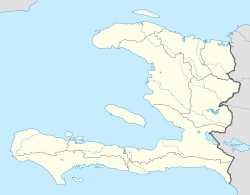Port-de-Paix
| Port-de-Paix | |
|---|---|
| Commune | |
| Location in Haiti | |
| Coordinates: 19°57′0″N 72°50′0″W / 19.95000°N 72.83333°W | |
| Country |
|
| Department | Nord-Ouest |
| Arrondissement | Port-de-Paix |
| Government | |
| • Mayor | Vacate |
| Population (2015) | |
| • Commune | 462,000 |
| • Metro | 306,217 |
| Time zone | Eastern (UTC-5) |
| • Summer (DST) | Eastern (UTC-4) |
Port-de-Paix (Haitian Creole: Pòdepè or Pòdpè) is a commune and the capital of the Nord-Ouest department in Haïti on the Atlantic coast. It has a population of 462,000 (2015 census IHSI). Port-de-Paix used to be a large exporter of bananas and coffee.
Before this area was called "Xarama" during the Amerindian "Taïno" belongs to "Bainoa" the fourth of the five caciquats shared the island of Haiti where its capital was "Mariena" called by the French "Le Marien" today Plaine-du-Nord. The area around the town was given the name "Valparaíso" by Christopher Columbus after landing here in the late evening of December 6, 1492, and still contains many attractive beaches and caves locations. A ferry operates between the town and Tortuga island (La Tortue), called "Gusaeni Cahini" by the Taïnos and is situated just across the water.
The town was founded in 1665 by French filibusters, driven from Tortuga Island by the British occupiers. In 1676 the capital of the French Colony of Saint-Domingue was moved from Tortuga to Port-de-Paix, and it remained the seat of government until 1711 when the capital was moved to Cap-Français. In 1676, Padrejean escaped from slavery in the Port. In 1679 the town saw the first black slave revolt. The area saw great success during the 19th century but in 1802 the town was almost entirely destroyed by fire, and never attained its former status.
Port-de-Paix is also the chief town of an arrondissement of the same name. The arrondissement consists of five communes: Port-de-Paix, La Pointe des Palmistes, Bassin-Bleu, Chansolme and Tortuga.
...
Wikipedia

